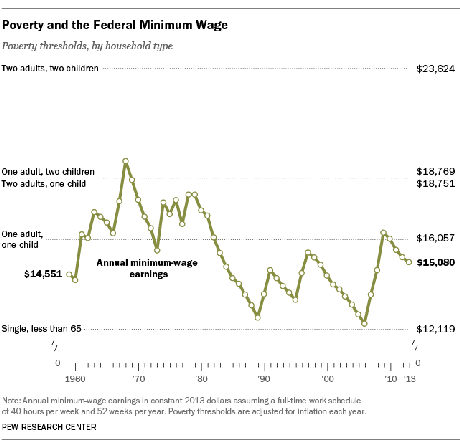 This chart shows the history of the minimum wage (in 2013 dollars) and its comparison to what would be required to meet the various poverty levels. As you can easily see, only a single person who is working for minimum wage could stay above the defined poverty level -- and sadly, most people working for the minimum wage are not single (nor are the teenagers, as the GOP would have us believe).
This chart shows the history of the minimum wage (in 2013 dollars) and its comparison to what would be required to meet the various poverty levels. As you can easily see, only a single person who is working for minimum wage could stay above the defined poverty level -- and sadly, most people working for the minimum wage are not single (nor are the teenagers, as the GOP would have us believe).A single parent with one or two children (a common thing in our current society) would make far less than what would be required to keep that family above the poverty level. And there's simply no way a married couple with two children can even come close to rising above the poverty level while working for minimum wage. This is why 20% of American children are living in poverty -- not because their parent is lazy, but because they work hard at a full-time job that pays a wage that keeps them in poverty.
Even more troubling is the fact that the situation is not getting any better -- it is getting worse. Most of the new jobs being created are jobs that pay at or near the minimum wage, and it is expected that by the early 2020's at least 20% of the workforce in this country will be working for the minimum wage (or very near it). With a workforce of over 150 million, that means more than 30 million will be working for poverty wages.
That should shame every American, since we live in the richest country in the world -- a country that could afford to pay workers a decent wage. But too many of our leaders, both in industry and government, simply don't respect workers. They don't care that they are forcing hard-working people to live in poverty, and some (the Republicans in Congress) would like to abolish the minimum wage and let employers pay even less than the currently required $7.25 an hour.
We don't just need to raise the country's minimum wage -- we need to raise it substantially, to at least $10.10 an hour. That may sound like a lot when compared to the current vastly inadequate minimum wage, but it is only about $21,000 (less than half of the median wage in the U.S.). And after it is raised, it should be tied to the rate of inflation, so its buying power doesn't immediately start to disintegrate.

